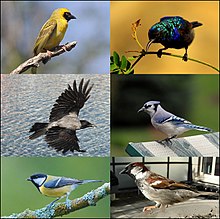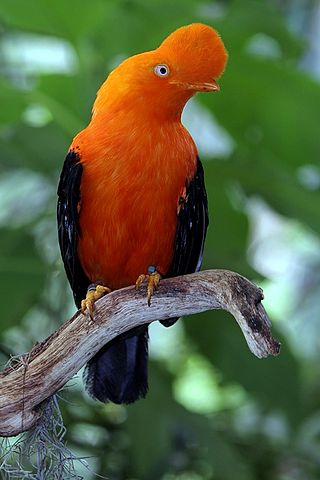นกเกาะคอน หรือ นกจับคอน เป็นอันดับของนกอันดับหนึ่ง ในกลุ่มนกขากรรไกรแบบใหม่ ใช้ชื่อวิทยาศาสตร์ว่า Passeriformes (โดยมีที่มาจาก Passer domesticus ซึ่งเป็นชื่อวิทยาศาสตร์ของนกกระจอกใหญ่ และนกในสกุล Passer ที่เป็นนกขนาดเล็กที่ใกล้เคียงกัน)
| นกเกาะคอน ช่วงเวลาที่มีชีวิตอยู่: สมัยอีโอซีน-ปัจจุบัน, 52.5–0Ma | |
|---|---|
 | |
| การจำแนกชั้นทางวิทยาศาสตร์ | |
| อาณาจักร: | Animalia |
| ไฟลัม: | Chordata |
| ไม่ได้จัดลำดับ: | Archosauria |
| ชั้น: | Aves |
| อันดับใหญ่: | Neoaves |
| อันดับ: | Passeriformes Linnaeus, 1758 |
| วงศ์: | ราว 140 วงศ์ มากกว่า 6,500 ชนิด[1] |
| อันดับย่อย | |
| |
นกในอันดับนี้มีลักษณะทั่วไปทางกายภาค คือ เป็นนกที่มีวิวัฒนาการเพื่ออาศัยและหากินบนต้นไม้เป็นหลัก นิ้วตีนมีทั้งหมด 4 นิ้ว ทุกนิ้วเจริญดีและอยู่ในระนาบเดียวกัน จึงเหมาะแก่การจับหรือเกาะเกี่ยวกับกิ่งไม้หรือต้นไม้ในป่าประเภทต่าง ๆ แต่ไม่เหมาะสำหรับการเดินบนพื้นดิน ดังนั้นเมื่อเมื่อลงดินจะได้วิธีก้าวกระโดด โดยมากแล้วจะเป็นนกที่มีลำตัวขนาดเล็ก[2]
ปัจจุบัน นักปักษีวิทยาได้แบ่งอันดับนี้เป็นอันดับย่อย 3 อันดับ โดยพิจารณาจากกล้ามเนื้อควบคุมกล่องเสียงที่อยู่ในลำคอ โดยบางอันดับย่อยจะมีกล้ามเนื้อนี้เพียง 2 คู่ ซึ่งยังเป็นลักษณะของนกในยุคก่อนประวัติศาสตร์ ทำให้เสียงร้องไม่ไพเราะนัก แต่บางอันดับย่อยมีมากกว่า คือมี 4 คู่ ทำให้มีเสียงร้องที่ไพเราะกว่า[3]
นกในอันดับนี้มีมากกว่า 140 วงศ์ ประมาณ 6,500 ชนิด ทั่วโลก[1] สำหรับในประเทศไทยที่มีการค้นพบนกแล้วราว 1,000 ชนิด แบ่งเป็นนกในอันดับต่าง ๆ 16 อันดับ ใน 70 วงศ์ นกที่อยู่ในอันดับนี้นับว่ามากกว่าครึ่ง ได้แก่[4]
อนุกรมวิธาน
Suborder Acanthisitti
- Acanthisittidae: New Zealand wrens


Suborder Tyranni (suboscines)
- Infraorder Eurylaimides: Old World suboscines
- Philepittidae: asities
- Eurylaimidae: typical broadbills
- Calyptomenidae: African and green broadbills
- Sapayoidae: broad-billed sapayoa
- Pittidae: วงศ์นกแต้วแร้ว (pittas)
- Infraorder Tyrannides: New World suboscines
- Parvorder Furariida
- Melanopareiidae: crescentchests
- Conopophagidae: gnateaters and gnatpittas
- Thamnophilidae: antbirds
- Grallariidae: antpittas
- Rhinocryptidae: typical tapaculos
- Formicariidae: antthrushes
- Furnariidae: ovenbirds and woodcreepers
- Parvorder Tyrannida
- Pipridae: manakins
- Cotingidae: cotingas
- Tityridae: tityras and allies
- Tyrannidae: tyrant flycatchers
Suborder Passeri (oscines)

- Atrichornithidae: scrub-birds
- Menuridae: lyrebirds
- Climacteridae: Australian treecreepers
- Ptilonorhynchidae: bowerbirds
- Maluridae: fairywrens, emu-wrens and grasswrens
- Dasyornithidae: bristlebirds
- Pardalotidae: pardalotes
- Acanthizidae: scrubwrens, thornbills, and gerygones
- Meliphagidae: honeyeaters
- Pomatostomidae: pseudo-babblers
- Orthonychidae: logrunners

- Infraorder Corvides
- Cinclosomatidae: jewel-babblers, quail-thrushes
- Campephagidae: cuckooshrikes and trillers
- Mohouidae: whiteheads
- Neosittidae: sittellas
- Superfamily Orioloidea[a]
- Psophodidae: whipbirds
- Eulacestomidae: wattled ploughbills
- Falcunculidae: shriketit
- Oreoicidae: Australo-Papuan bellbirds
- Paramythiidae: painted berrypeckers
- Vireonidae: vireos
- Pachycephalidae: whistlers
- Oriolidae: วงศ์นกขมิ้น (Old World orioles and figbirds)
- Superfamily Malaconotoidea[b]

- Machaerirhynchidae: boatbills
- Artamidae: woodswallows, butcherbirds, currawongs, and Australian magpie
- Rhagologidae: mottled whistler
- Malaconotidae: puffback shrikes, bush shrikes, tchagras, and boubous
- Pityriaseidae: bristlehead
- Aegithinidae: ioras
- Platysteiridae: wattle-eyes and batises
- Vangidae: vangas
- Superfamily Corvoidea[c]
- Rhipiduridae: fantails
- Dicruridae: วงศ์นกแซงแซว (drongos)
- Monarchidae: monarch flycatchers
- Ifritidae: blue-capped ifrit
- Paradisaeidae: วงศ์นกปักษาสวรรค์ (birds-of-paradise)
- Corcoracidae: white-winged chough and apostlebird
- Melampittidae: melampittas
- Laniidae: วงศ์นกอีเสือ (shrikes)
- Corvidae: วงศ์นกกา (crows, ravens, and jays)

- Infraorder Passerides
- Cnemophilidae: satinbirds
- Melanocharitidae: berrypeckers and longbills
- Callaeidae: New Zealand wattlebirds
- Notiomystidae: stitchbird
- Petroicidae: Australian robins
- Eupetidae: rail-babbler
- Picathartidae: rockfowl
- Chaetopidae: rock-jumpers

- Parvorder Sylviida[d]
- Hyliotidae: hyliotas
- Stenostiridae: fairy flycatchers
- Paridae: tits, chickadees and titmice
- Remizidae: penduline tits
- Panuridae: bearded reedling
- Alaudidae: วงศ์นกจาบฝน หรือนกลาร์ค (larks)
- Nicatoridae: nicators
- Macrosphenidae: crombecs and African warblers
- Cisticolidae: cisticolas and allies
- Superfamily Locustelloidea
- Acrocephalidae: reed warblers, Grauer’s warbler and allies
- Locustellidae: grassbirds and allies
- Donacobiidae: black-capped donacobius
- Bernieridae: Malagasy warblers
- —
- Pnoepygidae: wren-babblers
- Hirundinidae: วงศ์นกนางแอ่น (swallows and martins)
- Superfamily Sylvioidea
- Pycnonotidae: วงศ์นกปรอด (bulbuls)
- Sylviidae: sylviid babblers
- Paradoxornithidae: parrotbills and myzornis
- Zosteropidae: white-eyes
- Timaliidae: วงศ์นกกินแมลงและนกกะราง (tree babblers)
- Leiothrichidae: laughingthrushes and allies
- Alcippeidae: Alcippe fulvettas
- Pellorneidae: วงศ์นกมุ่นรก (ground babblers)
- Superfamily Aegithaloidea
- Phylloscopidae: leaf-warblers and allies
- Hyliidae: hylias
- Aegithalidae: long-tailed tits or bushtits
- Scotocercidae: streaked scrub warbler
- Cettiidae: Cettia bush warblers and allies
- Erythrocercidae: yellow flycatchers
- Parvorder Muscicapida
- Superfamily Bombycilloidea
- Dulidae: palmchat
- Bombycillidae: waxwings
- Ptiliogonatidae: silky flycatchers
- Hylocitreidae: hylocitrea
- Hypocoliidae: hypocolius
- Mohoidae: oos
- Superfamily Muscicapoidea
- Elachuridae: spotted elachura
- Cinclidae: dippers
- Muscicapidae: วงศ์นกจับแมลงและนกเขน (Old World flycatchers and chats)
- Turdidae: วงศ์นกเดินดง (thrushes and allies)
- Buphagidae: oxpeckers
- Sturnidae: วงศ์นกเอี้ยงและนกกิ้งโครง (starlings and rhabdornis)
- Mimidae: mockingbirds and thrashers
- —
- Regulidae: goldcrests and kinglets
- Superfamily Certhioidea
- Tichodromidae: wallcreeper
- Sittidae: วงศ์นกไต่ไม้ (nuthatches)
- Certhiidae: treecreepers
- Polioptilidae: gnatcatchers
- Troglodytidae: wrens
- Parvorder Passerida
- Promeropidae: sugarbirds
- Modulatricidae: dapple-throat and allies
- Nectariniidae: วงศ์นกกินปลี (sunbirds)
- Dicaeidae: flowerpeckers
- Chloropseidae: นกเขียวก้านตอง (leafbirds)
- Irenidae: นกเขียวคราม (fairy-bluebirds)
- Peucedramidae: olive warbler
- Urocynchramidae: Przewalski's finch
- Ploceidae: วงศ์นกจาบ (weavers)
- Viduidae: indigobirds and whydahs
- Estrildidae: วงศ์นกกระติ๊ด (waxbills, munias and allies)
- Prunellidae: accentors
- Passeridae: วงศ์นกกระจอก (Old World sparrows and snowfinches)
- Motacillidae: wagtails and pipits
- Fringillidae: finches and euphonias
- Rhodinocichlidae: rosy thrush-tanager
- Calcariidae: longspurs and snow buntings
- Emberizidae: buntings
- Cardinalidae: cardinals
- Mitrospingidae: mitrospingid tanagers
- Thraupidae: tanagers and allies
- Passerellidae: New World sparrows, bush tanagers
- Parulidae: New World warblers
- Icteriidae: yellow-breasted chat
- Icteridae: grackles, New World blackbirds, and New World orioles
- Calyptophilidae: chat-tanagers
- Zeledoniidae: wrenthrush
- Teretistridae: Cuban warblers[f]
- Nesospingidae: Puerto Rican tanager
- Spindalidae: spindalises
- Phaenicophilidae: Hispaniolan tanagers
| Passeriformes classification | |||||||||||||||||||||||||||||||||||||||||||||||||||||||||||||||||||||||||||||||||||||||||||||||||||||||||||||||||||||||||||||||||||||||||||||||||||||||||||||||||||||||||||||||||||||||||||||||||||||||||||||||||||||||||||||||||||||||||||||||||||||||||||||||||||||||||||||||||||||||||||||||||||||||||||||||||||||||||||||||||||||||||||||||||||||||||||||||||||||||||||||||||||||||||||||||||||||||||||||||||||||||||||||||||||||||||||||||||||||||||||||||||||||||||||||||||||||||||||||||||||||||||||||||||||||||||||||||||||||||||||||||||||||||||||||||||||||||||||||||||||||||||||||||||||||||||||||||||||||||||||||||||||||||||||||||||||||||||||||||||||||||||||||||||||||||||||||||||||||||||||||||||||||||||||||||||||||||||||||||||||||||||||||||||||||||||||||||||||||||||||||||||||||||||||||||||||||||||||||||||||||||
|---|---|---|---|---|---|---|---|---|---|---|---|---|---|---|---|---|---|---|---|---|---|---|---|---|---|---|---|---|---|---|---|---|---|---|---|---|---|---|---|---|---|---|---|---|---|---|---|---|---|---|---|---|---|---|---|---|---|---|---|---|---|---|---|---|---|---|---|---|---|---|---|---|---|---|---|---|---|---|---|---|---|---|---|---|---|---|---|---|---|---|---|---|---|---|---|---|---|---|---|---|---|---|---|---|---|---|---|---|---|---|---|---|---|---|---|---|---|---|---|---|---|---|---|---|---|---|---|---|---|---|---|---|---|---|---|---|---|---|---|---|---|---|---|---|---|---|---|---|---|---|---|---|---|---|---|---|---|---|---|---|---|---|---|---|---|---|---|---|---|---|---|---|---|---|---|---|---|---|---|---|---|---|---|---|---|---|---|---|---|---|---|---|---|---|---|---|---|---|---|---|---|---|---|---|---|---|---|---|---|---|---|---|---|---|---|---|---|---|---|---|---|---|---|---|---|---|---|---|---|---|---|---|---|---|---|---|---|---|---|---|---|---|---|---|---|---|---|---|---|---|---|---|---|---|---|---|---|---|---|---|---|---|---|---|---|---|---|---|---|---|---|---|---|---|---|---|---|---|---|---|---|---|---|---|---|---|---|---|---|---|---|---|---|---|---|---|---|---|---|---|---|---|---|---|---|---|---|---|---|---|---|---|---|---|---|---|---|---|---|---|---|---|---|---|---|---|---|---|---|---|---|---|---|---|---|---|---|---|---|---|---|---|---|---|---|---|---|---|---|---|---|---|---|---|---|---|---|---|---|---|---|---|---|---|---|---|---|---|---|---|---|---|---|---|---|---|---|---|---|---|---|---|---|---|---|---|---|---|---|---|---|---|---|---|---|---|---|---|---|---|---|---|---|---|---|---|---|---|---|---|---|---|---|---|---|---|---|---|---|---|---|---|---|---|---|---|---|---|---|---|---|---|---|---|---|---|---|---|---|---|---|---|---|---|---|---|---|---|---|---|---|---|---|---|---|---|---|---|---|---|---|---|---|---|---|---|---|---|---|---|---|---|---|---|---|---|---|---|---|---|---|---|---|---|---|---|---|---|---|---|---|---|---|---|---|---|---|---|---|---|---|---|---|---|---|---|---|---|---|---|---|---|---|---|---|---|---|---|---|---|---|---|---|---|---|---|---|---|---|---|---|---|---|---|---|---|---|---|---|---|---|---|---|---|---|---|---|---|---|---|---|---|---|---|---|---|---|---|---|---|---|---|---|---|---|---|---|---|---|---|---|---|---|---|---|---|---|---|---|---|---|---|---|---|---|---|---|---|---|---|---|---|---|---|---|---|---|---|---|---|---|---|---|---|---|---|---|---|---|---|---|---|---|---|---|---|---|---|---|---|---|---|---|---|---|---|---|---|---|---|---|---|---|---|---|---|---|---|---|---|---|---|---|---|---|---|---|---|---|---|---|---|---|---|---|---|---|---|---|---|---|---|---|---|---|---|---|---|---|---|---|---|---|---|---|---|---|---|---|---|---|---|---|---|---|---|---|---|---|---|---|---|---|---|---|---|---|---|---|---|---|---|---|---|---|---|---|---|---|---|---|---|---|---|---|---|---|---|---|---|---|---|---|---|---|---|---|---|---|---|---|---|---|---|---|---|---|---|---|---|---|---|---|---|---|---|---|---|---|---|---|---|---|---|---|---|---|---|---|---|---|---|---|---|---|---|---|---|---|---|---|---|---|---|---|---|---|---|---|---|---|---|---|---|---|---|---|---|---|---|---|---|---|---|---|---|---|---|---|---|---|---|---|---|---|---|---|
|
อ้างอิง
แหล่งข้อมูลอื่น
Wikiwand in your browser!
Seamless Wikipedia browsing. On steroids.
Every time you click a link to Wikipedia, Wiktionary or Wikiquote in your browser's search results, it will show the modern Wikiwand interface.
Wikiwand extension is a five stars, simple, with minimum permission required to keep your browsing private, safe and transparent.
